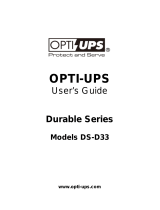
User’s manual 2 UPS EVO DSP TT
Index
1 Safety .......................................................................................................... 4
2 Installation .................................................................................................... 5
2.1 Transportation ............................................................................................. 5
2.2 Unpacking................................................................................................... 5
2.3 Storage...................................................................................................... 5
2.4 Location and Connection of the UPS ................................................................... 5
2.4.1 Environmental Requisites........................................................................................5
2.4.2 Electrical Requisites ..............................................................................................6
2.5 Connections ................................................................................................ 7
2.5.1 Internal Battery Connection.....................................................................................8
2.5.2 Power Connections................................................................................................9
2.5.2.1 Protective Earth (Ground) Connections.............................................................9
2.5.2.2 Input Connection .......................................................................................9
2.5.2.3 Separated Bypass Mains Input Connection (Optional) .......................................... 10
2.5.2.4 External Battery Connection .......................................................................10
2.5.2.5 Output Connection................................................................................... 10
2.5.3 Communication Interfaces Connections .....................................................................10
3 Operating Modes ............................................................................................11
3.1 Bypass Mode...............................................................................................12
3.2 Normal Mode ..............................................................................................13
3.3 Battery Mode..............................................................................................13
4 Control and Monitoring ....................................................................................14
4.1 Front Panel................................................................................................14
4.1.1 Keypad............................................................................................................ 14
4.1.2 Mimic Panel ......................................................................................................15
4.1.3 Liquid Crystal Display (LCD) and User Menu................................................................. 16
4.1.4 Buzzer............................................................................................................. 19
5 Operating Procedures......................................................................................20
5.1 Commissioning ............................................................................................20
5.2 Decommissioning .........................................................................................20
5.3 Switching into Manual Bypass during Operation.....................................................21
5.4 Returning from Manual Bypass to UPS.................................................................21
5.5 Connection to a Generator..............................................................................21
6 Operating Procedures for Parallel System.............................................................22
6.1 Introduction ...............................................................................................22
6.2 Procedure for Commissioning and Start Up (First Installation) ...................................22
6.3 Procedure for Transferring to Static Bypass .........................................................25
6.4 Procedure for Transferring to (Maintenance) Manual Bypass......................................25
6.5 Procedure for Switching OFF ...........................................................................25
7 Features and Operating Limits...........................................................................26
7.1 Mains Limits for Normal mode..........................................................................26
7.2 Bypass Mains Limits for Bypass mode..................................................................26
7.3 Battery Test...............................................................................................26
7.4 Overload Behavior........................................................................................27
7.5 Electronic Short Circuit Protection....................................................................27






















